Canyon Spectral 125
Wheel Size: 29’’
Travel: 125 mm rear / 140 mm front
Material: Aluminum and Carbon Fiber versions available
Price:
Complete bikes: $2,899 – $6,299
Reviewers:
- David Golay (6′, 170 lb / 183 cm, 77.1 kg)
- Zack Henderson (6′, 160 lb / 183 cm, 72.6 kg)
Test Location: Washington
Test Duration: 4 months
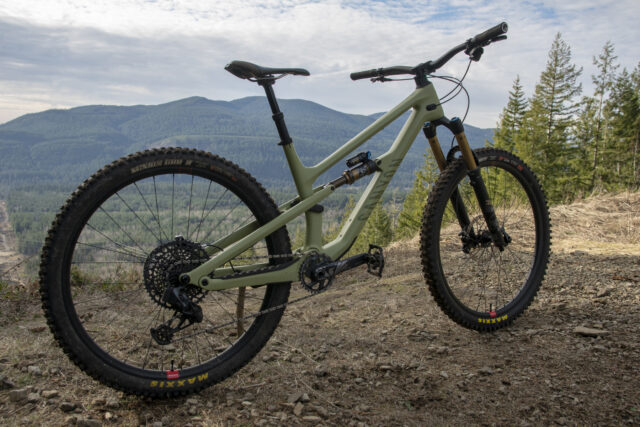
Intro
Right on the heels of us dropping our full review of the Spectral 29, Canyon has just released a shorter-travel version, the Spectral 125. The rear-wheel travel is, predictably, down to 125 mm (from 150 mm on its bigger sibling), but the geometry hasn’t been mellowed out to match. Canyon hasn’t just slapped a shorter fork and shock on the existing Spectral 29, though, and what they put together looks awfully interesting.
The Frame
As with the standard Spectral, the Spectral 125 is available in both aluminum and carbon fiber frames, but it does forgo the multiple wheel size options on the bigger bike — the 125 is 29’’ only. The overall layout of the Spectral 125 is essentially identical to the standard Spectral, with a Horst Link layout driving a horizontally mounted shock. That configuration leaves room for a smaller water bottle underneath the shock inside the front triangle, but bigger bottles won’t fit. The Spectral 125 is designed around a 140mm-travel fork.
The biggest difference between the aluminum and carbon frames is, of course, weight — the carbon frame is stated to shave about 500 g off the aluminum version. It’s also got a few extra bells and whistles, including a flip chip to adjust the geometry (more on that in a minute), fully guided internal cable routing, and replaceable steel inserts for all the pivot hardware threads.
The Spectral 125 AL loses the flip chip and cable guides (the routing is still internal, though) and uses fixed steel inserts for the pivot threads. Neither frame comes with ISCG tabs as standard, though an add-on set is available separately for the carbon version. Both get a threaded bottom bracket shell, post mount brake tabs for a 180 mm rotor, and rubber guards on the chainstay, seatstay, and downtube.



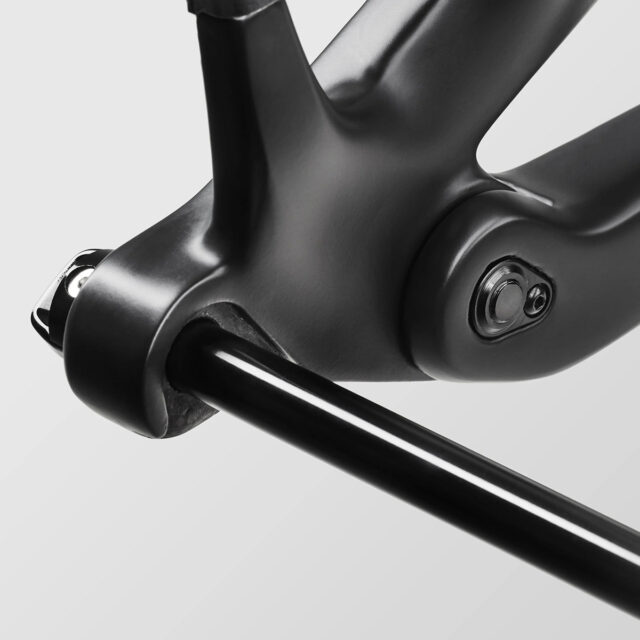
There’s room for a piggyback air shock (and a number of the complete bikes come with one) but Canyon says that coil shocks aren’t supported for clearance reasons. The Spectral 125 has been made a touch more progressive, compared to the standard Spectral, to help keep it from blowing through its more limited travel, and Canyon recommends running 25% sag.
The Spectral 125 carbon is stated to be about 100 g lighter than the carbon version of the standard Spectral (at 2,500 g vs. 2,600 g), but the Spectral 125 is still built to the same testing standards that Canyon applies to their Enduro bikes — it’s supposed to be a burly frame that aggressive riders can push hard, just with a little less travel to make it more lively and poppy.
The Spectral 125 joins the Neuron in Canyon’s Trail bike line, and while they’ve got very similar amounts of travel (the Neuron is 130 mm rear / 140 mm front), their geometry is wildly different. The Neuron is much steeper (67° headtube angle), features a slacker seat tube angle, shorter reach, etc. And the builds that are offered on the Neuron are significantly less burly to match. Canyon describes the Neuron as being more versatile and well-rounded, while the Spectral 125 is unapologetically gravity-focused, and that makes a lot of sense.
Fit & Geometry
The Spectral 125 is available in four sizes, Small through XL, with reach ranging from 435 mm on the Small through 511 mm on the XL, in roughly 25 mm increments between sizes. All sizes get a 76.5° effective seat tube angle, 437 mm chainstays, and — probably the most surprising number on the Spectral 125’s geometry chart — a 64° headtube angle. Those numbers are all stated in the low position of the flip-chip on the carbon frame, which is the only setting on the aluminum option. The carbon version’s high setting steepens everything by 0.5° and raises the bottom bracket slightly, though the exact amount isn’t stated.
The Builds
Canyon offers five builds on the Spectral 125, with two offered on the aluminum frame and three on the carbon option. As per usual for Canyon, they’re notably good values for the money, and they’re also pretty burly builds for such a short travel bike — which makes a lot of sense, given the geometry Canyon has given the Spectral 125.
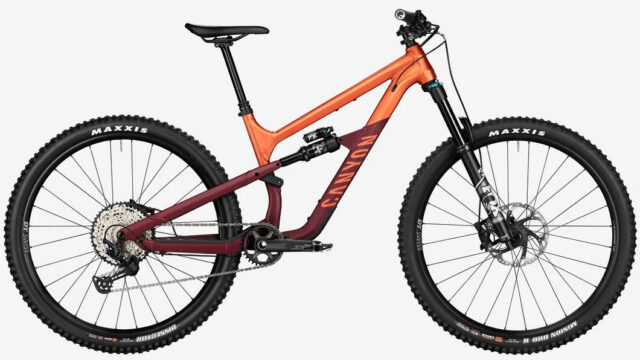
- Drivetrain: Shimano Deore
- Brakes: Shimano Deore 4-piston
- Fork: RockShox 35 Gold RL
- Shock: RockShox Deluxe Select+
- Wheels: RaceFace AR30 rims / Shimano MT400 hubs
- Dropper Post: Canyon Iridium
- Drivetrain: Shimano SLX
- Brakes: Shimano SLX 4-piston
- Fork: Fox 36 Rhythm
- Shock: Fox Float X Performance
- Wheels: DT Swiss AM LN 370
- Dropper Post: Canyon Iridium
- Drivetrain: SRAM GX
- Brakes: SRAM Code RS
- Fork: RockShox Pike Select+
- Shock: RockShox Deluxe Select+
- Wheels: DT Swiss M1900
- Dropper Post: Canyon G5
- Drivetrain: Shimano XT
- Brakes: Shimano XT 4-piston
- Fork: Fox 36 Performance Elite
- Shock: Fox Float X Performance
- Wheels: DT Swiss XM 1700
- Dropper Post: Canyon G5
- Drivetrain: SRAM GX AXS
- Brakes: SRAM Code RSC
- Fork: Fox 36 Factory
- Shock: Fox Float X Factory
- Wheels: DT Swiss XMC 1501
- Dropper Post: Canyon G5
Those are notably beefy builds for a 125mm-travel Trail bike. All get 200/203 mm front rotors, 4-piston brakes, stout forks, and so on. And though they’re the higher-end builds and certainly not cheap, the Spectral 125 CF 8 and CF 9 might actually stand out as being the most impressive values in the bunch — in particular, the full Fox Factory-level suspension, SRAM AXS wireless drivetrain, and DT Swiss carbon wheels for $6,299 on the CF 9 is pretty wild.
Some Questions / Things We’re Curious About
(1) The Spectral 125 is clearly very aggressive and descending-oriented for a 125mm-travel Trail bike, but who does that mean it’ll work best for?
(2) And just how different does the Spectral 125 really feel, compared to the standard Spectral 29? Their geometry is nearly identical, so how much of a difference does the change in travel make?
FULL REVIEW
There’s a big range of ~120mm-travel Trail bikes out there, from light, sharp-handling XC-derived rigs to, well, the Canyon Spectral 125, which, on paper, is about as radically aggressive as that class of bike gets. Having now had two reviewers spend a bunch of time on the Spectral 125, we can say that it is indeed as game-on and descending-focused as it appears, which can both be a blast in the right circumstances, but does also come with some tradeoffs when it comes to versatility.
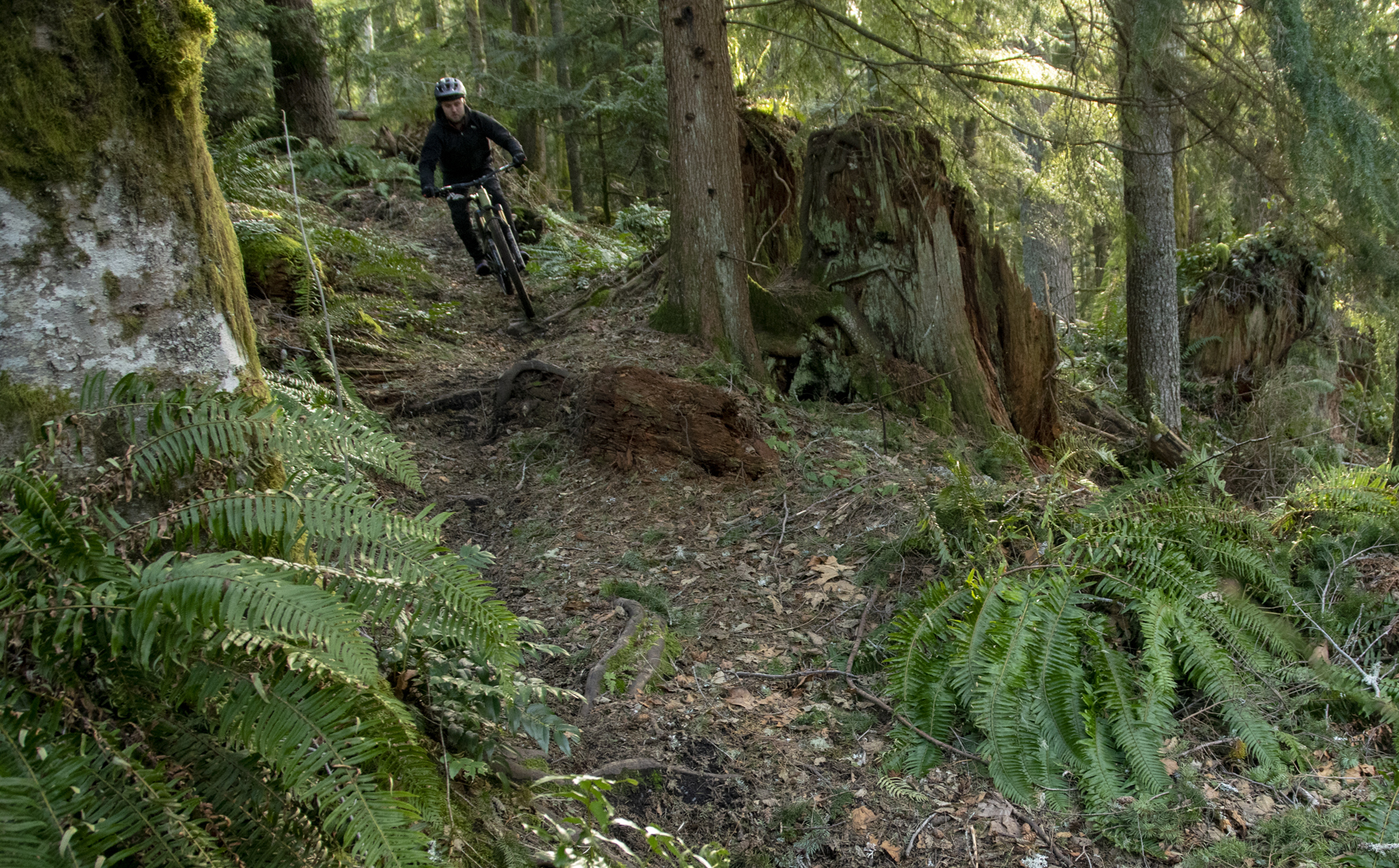
Fit & Sizing
David Golay: At 6’ (183 cm) tall, Canyon puts me in the overlapping range between the Medium and Large frames, and while I don’t think they’re wrong to suggest that I could ride either, nothing about the fit of the Large that we tested made me want to size down. The Spectral 125 is a relatively long, stable bike for this travel range, and, as we’ll get into more below, it wants some speed and aggression to come alive, rather than feeling immediately easy and intuitive in mellow, rolling, tighter terrain. If you’re worried about the Spectral 125 feeling too cumbersome and slow handling, my inclination is that you’re probably better off with a different bike entirely, rather than trying to size down and make the Spectral 125 into something that it’s not.
But as someone who spends a lot of time on big Enduro bikes and who is quite intrigued by the idea of such an aggressive short-travel Trail bike, I get along with the fit of the size Large Spectral 125 quite well. At 485 mm for our size Large test bike, the reach is on the long-ish side without being over the top, and while the stated seat tube angle of 76° is not exactly slack, the effective top tube is somewhat long at 642 mm as well. All of that is paired with a fairly average 632 mm stack height. While that’s not wildly short by any stretch, I do wish that Canyon left the steerer tube on the fork a little longer to leave more room to space the stem slightly higher — it’s easy to cut it down more later, after all, but you can’t add length back.
Zack Henderson: I’m just about the same exact height as David, but my proportions are a bit different, with my legs being a bit shorter and my torso being correspondingly longer. I felt quite strongly that the Large frame was the right fit for me, and while it is definitely a long bike, I found the cockpit to be a very comfortable place to spend a lot of hours in the saddle.
Given our similar stature, I won’t repeat too much of what David said since he covered the key fit points well. Like David, I found the front end to be a touch lower than I’d typically prefer for steeper terrain, and I found myself wishing for a little more steerer tube length so I could move the stem higher by another spacer or two. It wasn’t a deal breaker by any means, and a higher-rise bar could also accomplish a similar effect.

Climbing
David: I think opinions on the climbing performance of the Spectral 125 are going to be split pretty significantly based on the sorts of bikes folks come to the Spectral 125 from and what their expectations are. Compared to most long-travel Enduro bikes, the Spectral 125 is definitely more efficient under power, but it’s not terribly quick or snappy relative to a lot of bikes in its travel bracket. I’d put most of that down to the suspension performance; though the build on the Spectral 125 CF9 is definitely on the burlier side, it’s still not a heavy bike overall (30.8 lb / 14.0 kg, without pedals) and the really important stuff weight-wise (wheels and tires) are pretty light.
The pedaling position is good — and as we’ve said a lot of times before, dialing things back a notch on the seat tube angle is generally a good call for bikes that are supposed to be more versatile than full-on winch-and-plummet Enduro ones. I haven’t had trouble keeping the Spectral 125’s front wheel planted on even very steep climbs as long as I’m paying a modicum of attention to keeping my weight forward, though the somewhat long effective top tube does put a little extra tension in my lower back when doing so. But again, I think the tradeoffs that Canyon has made there are sensible for this sort of bike and I’m happier pedaling the Spectral 125 on flatter ground than I am with ultra-steep seat-tubed bikes like the Privateer 161.
The Spectral 125 is a competent enough technical climber, but maybe not an outstanding one. Its real wheel traction under power is respectable and it hasn’t displayed any actively troublesome behavior, but its long-ish wheelbase and somewhat low bottom bracket do make it a little more of a handful in tighter, more technical spots than some of the more XC-derived bikes in this travel class (see the “Comparisons” section, below). For what the Spectral 125 is trying to be — a very aggressive-descending short-travel bike — I think that tradeoff is entirely fair, and it’s still generally easier to manage than even bigger, longer Enduro bikes tend to be. So as always, it’s best to know thyself and what you really want from a bike, rather than expecting a very long, slack, short-travel bike to be some sort of best of both worlds in all situations.
Zack: More than other bikes I’ve tested recently, I came into my first ride on the Spectral 125 genuinely unsure of what to expect as far as climbing abilities. The Spectral 125 is relatively lightweight (30.8 lb / 14.0 kg, without pedals) and short on travel compared to a lot of other bikes I spend time on, but the length of the bike and its sensitive initial suspension feel seems more rooted in the Enduro realm.
David called it out well above, but I was happy to see a slightly slacker seat tube angle on this bike since it makes longer, more pedally rides on flatter terrain a bit more comfortable. Despite the comfortable pedaling position, however, I found the Spectral 125 to feel a bit more like a lightweight Enduro bike than a Trail bike on the climbs.

While Canyon has supposedly upped the anti-squat levels beyond the regular 150mm-travel Spectral, the Spectral 125 didn’t feel quite as firm and eager under power as many other Trail bikes I’ve ridden, and I’d even go so far as to say the early part of its travel felt a bit dead while climbing, rather than supportive, offering a lot of comfort and traction but not much of a get-up-and-go attitude that I often associate with bikes in this travel bracket. This sensation may also have been related to its long wheelbase and slack head angle, which I felt encouraged less technical line choice when climbing and more of a “build speed at the bottom and smash” tactic.
Now, before I come across as overly bearish on the Spectral 125’s climbing abilities, it’s also worth again highlighting the burly build’s influence on handling. A lighter fork, wheels, or tires could make a huge difference in the bike’s personality on the climbs — not a tradeoff I’d personally choose to make, given its descending performance, but something I would be curious to try down the road if I was a Spectral 125 owner.
Descending
David: Despite its modest suspension travel, the Spectral 125 is still clearly meant to prioritize performance on the way back down, and in the right circumstances, it’s a whole lot of fun there. As we’ve tended to find with this sort of aggressive short-travel Trail bike in general (again, see the Comparisons section, below) the Spectral 125 works best when being ridden with an aggressive approach that prioritizes going fast on the descents, but it doesn’t need an ultra-steep, fast trail to feel engaging. And for a skilled, aggressive rider, that combination can be a blast.
Even by the standards of the more aggressive bikes in this travel range, the Spectral 125 is notably more stable at speed and not as quick handling in slower, tighter spots than most. It wants a bit of room to run, but compared to a lot of bikes with similar geometry and more travel, it’s more lively feeling and is more eager to build speed by pumping through features.
One of the best things about aggressive short-travel bikes (or aggro hardtails) in general is that, when done right, they can corner like nothing else. The combination of longer, slacker geometry and the calmer steering and more stable platform that it produces, plus minimal suspension travel to mute your connection to the trail, can produce some cornering sensations that are hard to find elsewhere. And the Spectral 125 is very good on that front — but maybe not quite perfect.
The Spectral 125 (at least in the size Large that we’ve tested; since all four get the same 437 mm chainstays, I’d bet it varies a bit by frame size) has a definite preference for being ridden in a forward stance with relatively aggressive weighting of the front wheel. That’s no great surprise, given its relatively long front-center and not that long (though also not really short, granted) chainstays. And one of the results of that preferred body positioning is that the Spectral 125 corners best when you can get over the front, drive the front wheel into the apex, and stay light on the rear wheel to let it slide around.
And the Spectral 125 does that great. The cockpit is roomy enough that I’ve got space to move and find just the right balance point to control the way the wheels grip without feeling like the sweet spot is unduly small (which is the biggest reason that I have no interest in sizing down to a Medium frame, as discussed above) and the steering is pleasantly calm and not twitchy when making small corrections at speed.

I think I’d personally find the Spectral 125’s cornering a little better balanced if the chainstays were a touch longer and / or the bottom bracket a little lower, though. As described above, the Spectral 125 works really well when ridden in an aggressive, forward stance with a lot of weight on the front wheel, but when I wanted to instead load it up through the pedals and carve both tires through a well-supported corner, its sweet spot felt smaller, and I needed to be careful to not get too far back on the bike, lest the front tire lose grip. It’s plenty manageable, but not quite as fully intuitive as some other similar bikes I’ve been on recently when it comes to adapting to a wide variety of approaches to cornering.
I also have a hunch that finding a way to eke a little more midstroke support out of the suspension might help, too. The stock Fox Float X Factory rear shock is a good one, and the stock damper tune didn’t feel out of whack or anything like that, but (as I’ve written a few times recently) I’m really coming around to the idea that moderating the amount of linkage progression on a shorter-travel bike is a good idea, and while Canyon doesn’t list numbers for the Spectral 125, it feels quite progressive. Lots of progression is great if you want to make a bike very supple off the top while still maintaining support and bottom-out resistance later in the travel, but with just 125 mm available, there’s not really enough to have your cake and eat it too, so to speak. I’d rather accept that tradeoff — and indeed, a lively ride is kind of the point of an aggressive short-travel bike — and make the suspension firmer and more supportive.
Even when running relatively high air pressure in the rear shock (and having experimented with reducing the volume spacers to match, from the stock configuration of 0.3 in^3), the Spectral 125 felt like it used the initial part of its travel more readily than I’d have liked, both in high-speed rough sections and when preloading the suspension into a corner. It’s not like I found the Spectral 125 to be wildly lacking on that front, but with the fork set up to my liking, I had a hard time getting the two ends to feel 100% balanced, with the rear suspension feeling softer through the midstroke.
Going to the steeper geometry position actually makes the suspension feel a tiny bit less progressive which helped too, but I didn’t love the increased bottom bracket height that resulted for cornering reasons, so I overall preferred to leave the bike in the low setting and work on the suspension tuning around it.
Zack: The Spectral 125 is one of those bikes that seems destined to get you into trouble, and I mean that in the best way possible. On the way down the hill, it’s a very, very engaging mix of solid, responsive, and stable that encourages letting off the brakes and seeing just how much you can get away with, given just 125 mm of rear wheel travel.
I made a point to ride the Spectral 125 in all sorts of terrain, from flatter XC-style trails to high-speed bike-park-like trails with larger jumps and uber-steep natural terrain. Within that spectrum of trails, the Spectral 125 was decidedly happiest in the middle — it thrived on faster trails with larger jumps and high-speed corners, where its very progressive suspension responded well to pumping for free speed and where the longer reach and slacker head angle could lend some inspiration to keep going faster. The Spectral 125 is an exceptional jumper, and it’s among the first Trail bikes I’d be keen to take on a lap down A-Line, given its solid chassis and progressive suspension.
On more mellow trails, the Spectral 125 remained engaging and fun, but like a lot of Enduro bikes, it seemed to be begging for more speed to really come alive, and its length again could become a bit cumbersome in particularly tight and twisty terrain, where carrying speed through really tight corners is key. The rear suspension’s slight lack of support in the early and middle stroke, which David detailed above, made the bike feel a little less peppy than I’m used to at slower speeds, and quick direction changes at slower speeds often felt like they took a little more effort.
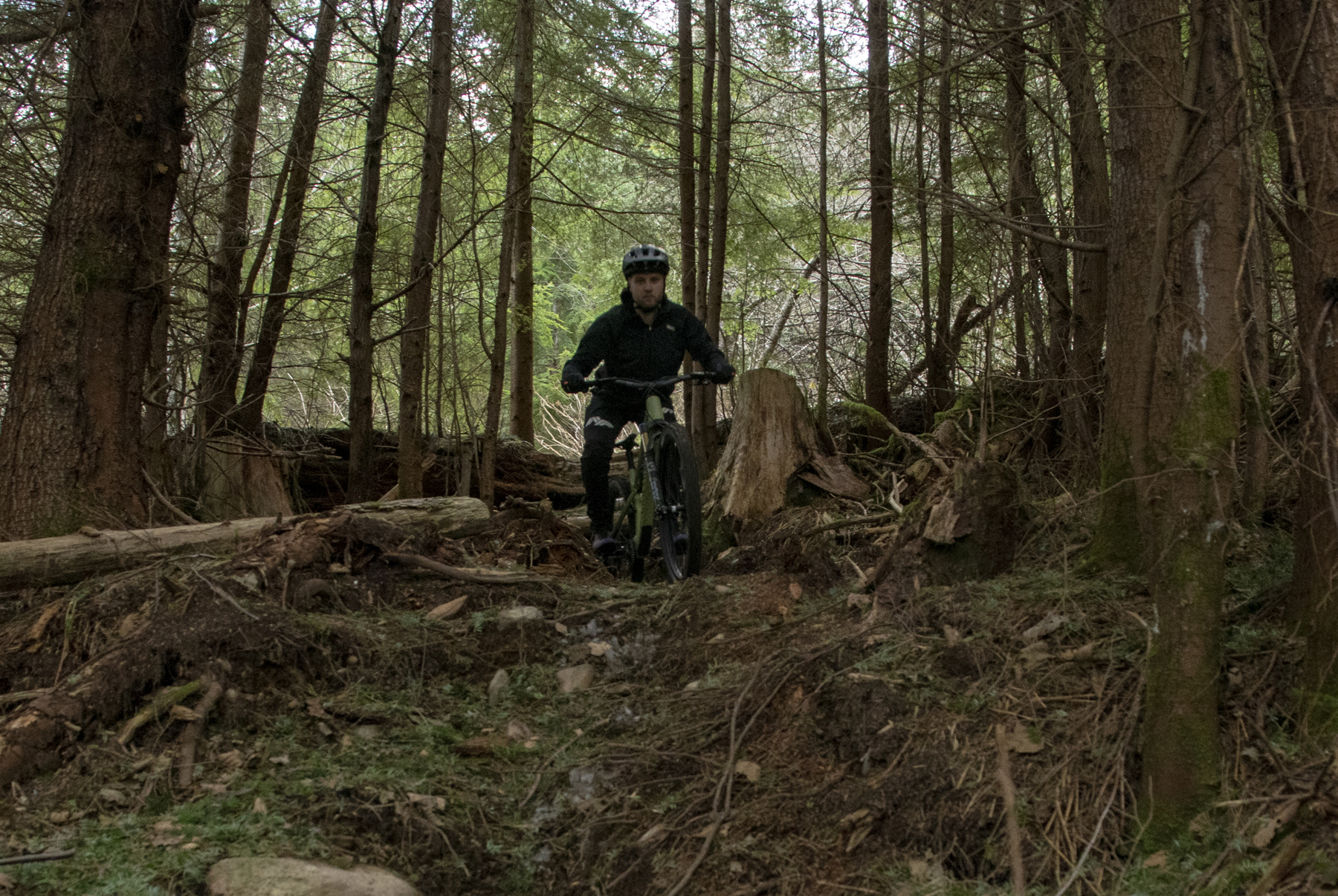
In really steep and natural terrain, the Spectral 125 could show some Jekyll / Hyde characteristics in that it could make you feel like a hero when you weighted the front end properly through a steep loose corner, but could subsequently feel like it wanted to kill you as you ran out of travel in a steep and technical chute, or if you didn’t weight the front end properly to keep the front wheel digging in. The short-ish chainstays required that I weight the front end quite deliberately, but then also required running a bit less fork sag to accommodate that extra pressure through the front of the bike, accentuating the mismatch with the somewhat softer initial travel of the rear suspension. Between this more demanding body position and the small amount of suspension travel, it could quickly become a tiring bike to ride on longer, more technical descents.
David unpacked the short chainstays predicament above, and while it’s entirely a personal preference thing for a lot of folks, I would love to see what another ~5 mm of chainstay length could do for this bike, as it might allow a bit more relaxed body positioning when the trail tipped downward.
The Build
David: The Spectral 125 is an undeniably outstanding value for money in terms of the parts spec, across seemingly all builds. A $6,300 price for the top-tier CF 9 build that we tested, with Fox Factory suspension, a SRAM GX AXS drivetrain, and DT Swiss XMC 1501 carbon wheels is pretty wild. And Canyon has done a nice job with the details, too. SRAM Code RSC brakes with a 200 mm front rotor might sound like a lot for a 125mm-travel bike but are welcome on one as aggressive as the Spectral 125; the size Large comes with a 200mm stroke dropper post, something that even some Enduro bikes still don’t manage; and so on.
That said, there are a few (mostly minor) rough edges when it comes to fit and finish. Our review bike shipped with a number of loose pivot bolts and generally not great assembly quality, so a thorough once-over before hitting the trails is probably prudent (not that it’s ever a bad idea). And even after my initial re-tightening, I had the main pivot axle come loose and creak a few times before I applied some more blue threadlocker to it.
The chainstay protector also doesn’t extend far enough forward to provide full coverage and the top edge of the chainstay is looking pretty rough as a result. There’s also a little noise coming from that area, though that part hasn’t been too bad. The front brake hose is a bit too long and coils inward awkwardly as a result, too.
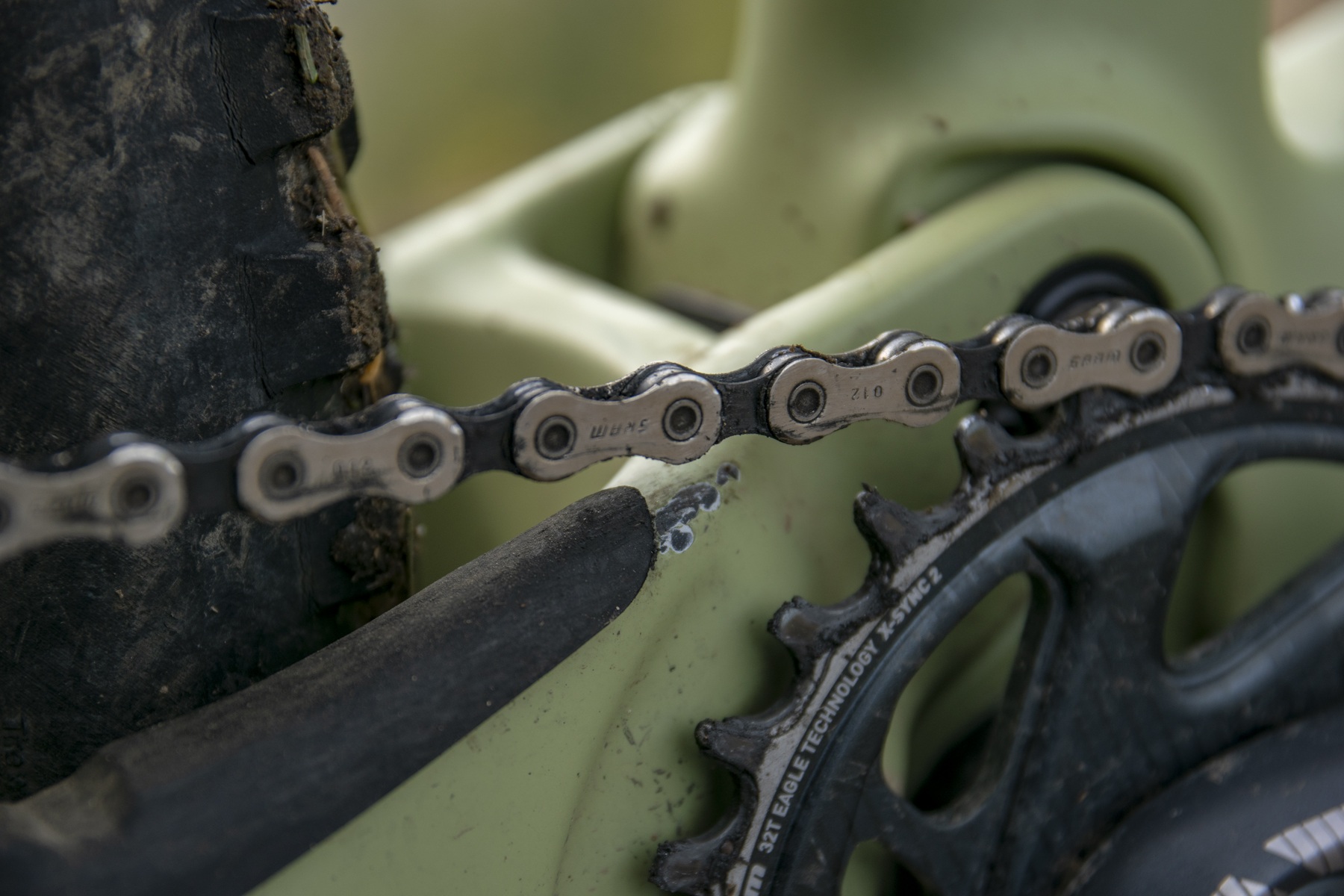
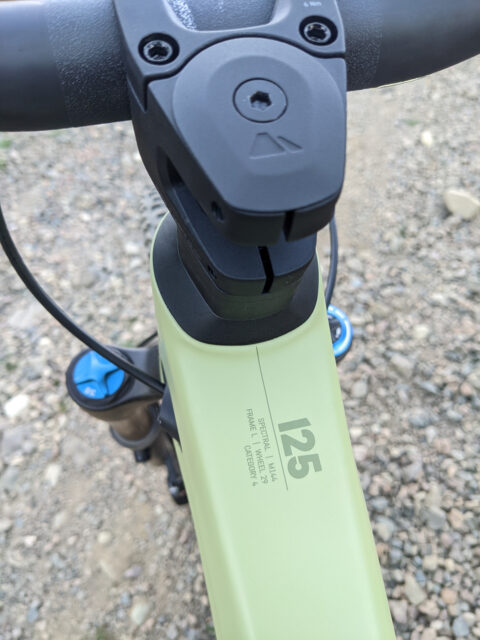
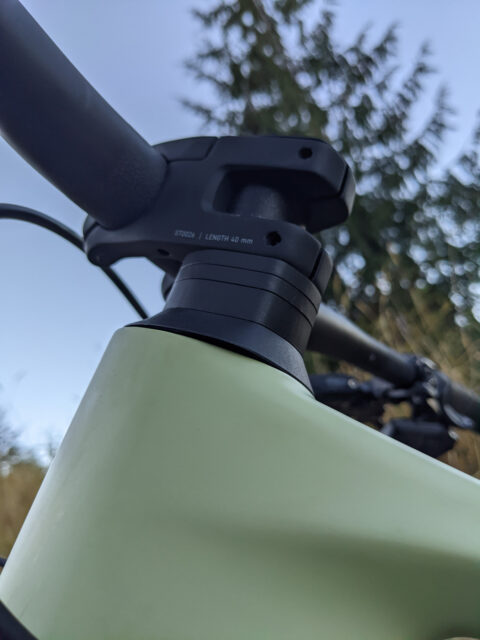
Would that stop me from buying a Spectral 125? Definitely not. It’s not that big a deal and is solvable if you really care. But it’s also annoying for no real benefit and is the kind of integration-oriented “refinement” that I really, really don’t want to see continue in the bike world. The modularity of mountain bikes is awesome from the standpoint of folks who want to be able to tailor things to their own personal preferences, and as far as I’m concerned, anything that detracts from that without a good performance reason for doing so is a step in the wrong direction. The stock seat also happened to really not agree with me, but seats are such a personal matter that it’s hard to draw many conclusions from that; your mileage almost certainly will vary.
Finally, I also swapped some stickier, beefier tires (mostly a Maxxis Shorty DoubleDown MaxxGrip front / Minion DHRII DoubleDown MaxxTerra rear combo) for a large part of my testing, just to better suit the greasy prevailing winter conditions. I’d have been happy with the stock Minion DHRII front / Dissector rear combo in drier times, and it’s just about impossible to land on a combo that’s the right call for everyone, everywhere, during all seasons. The stock package is plenty sensible, I just wanted something different.
Zack: David hit just about everything I’d want to touch on here, from the impressively well-sorted elements of the build (long dropper post, big rotors, etc.) to the form-over-function elements of the stem, spacer, and headset configuration.
Like David, I felt that the tire choice was best suited to dry conditions, but I didn’t swap on a beefier setup. On wetter rides, the stock MaxxTerra compound definitely slid around more than I’d like, but on a couple of fortunate dry days, I found that the lighter casing and firmer tread compound helped keep rolling speeds high. Given the capabilities of the Spectral 125, I’d imagine that a lot of riders may find themselves tempted to throw some stickier rubber up front, or potentially explore a heavier casing or insert setup in the rear wheel — I would strongly consider going that route if this was a long term ride for me.
While it’s more about the frame design than the build spec, I was pretty impressed by how clean and simple the frame architecture was. The hardware is largely hidden from view and the suspension arrangement is quite streamlined, and while that might all seem cosmetic, the bike did seem to pick up a lot less grit and grime while riding in some truly heinous winter conditions. I didn’t have the bike for long enough to comment on things like bearing longevity, but any time a bike can hang onto less of the mud and water from a wet ride, the better.
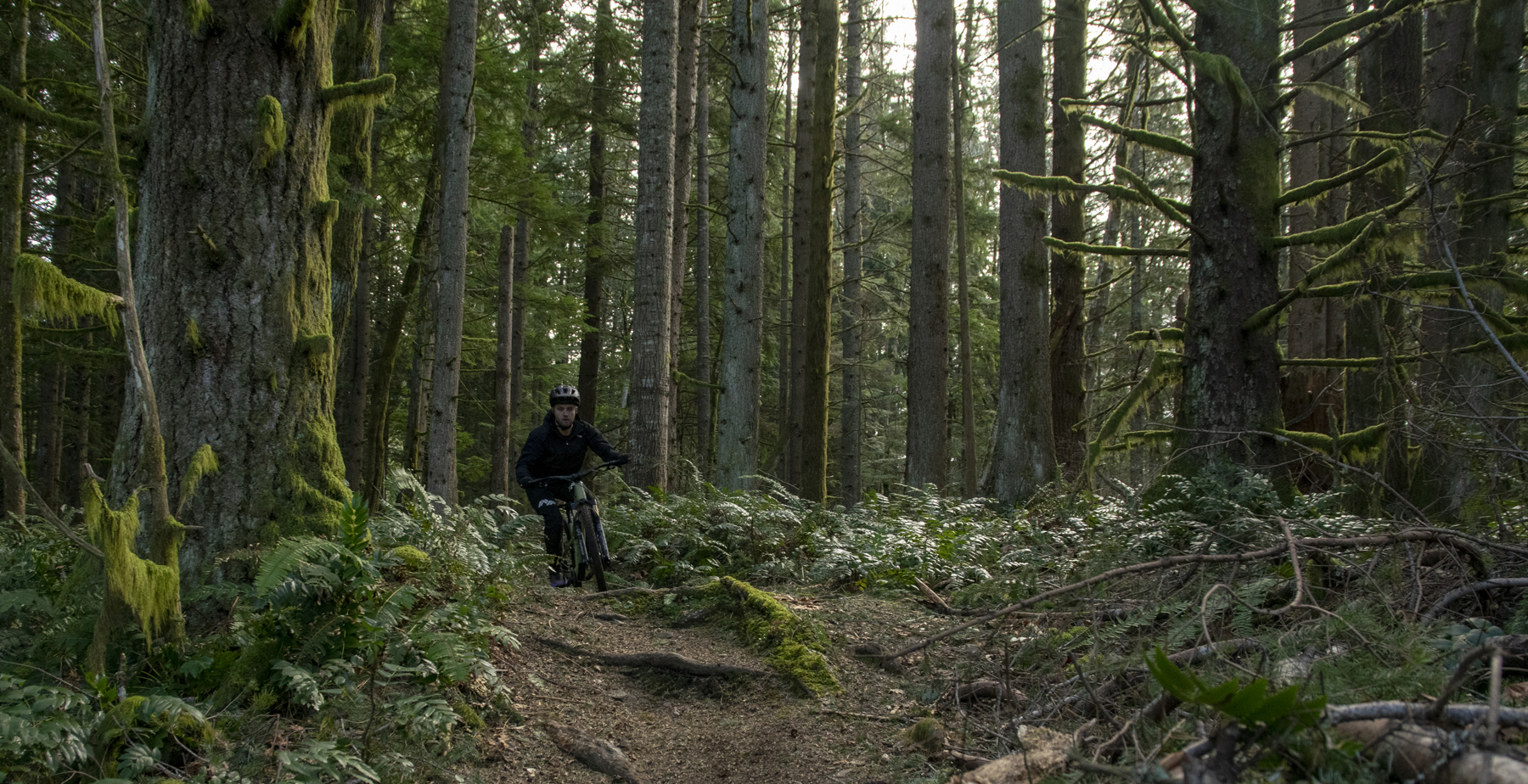
Comparisons
David: I need a lot more time on the new Transition Smuggler to fully sort out my thoughts on it, but my early impressions at this point are that it feels a lot like the Spectral 125, but with a lot of the small refinements that Zack and I mentioned wanting to see on the Canyon. They’re both stable, game-on takes on a shorter-travel Trail bike but the Smuggler pedals more efficiently, its suspension feels more supportive, and its handling feels more balanced and neutral in terms of its preferred body positioning and approach.
That said, the Spectral 125 comes out well ahead of the Smuggler in terms of value for money in the build spec, and I think the choice to go for a beefier Fox 36 fork in place of the 34 that comes on the Smuggler is a welcome one for this sort of bike.
Guerrilla Gravity Trail Pistol
David: This is probably the next best comparison here, after the Smuggler, especially with the Trail Pistol bumped up to 130 mm rear / 140 mm front travel by way of a longer-stroke shock and fork, which Guerrilla Gravity condones (and is my personal preferred setup for the bike). Overall, they’re both pretty stable, descending-oriented takes on a short-travel Trail bike that feel more like scaled-down Enduro bikes than slackened and lengthened XC rigs.
There are still some differences, though. The Spectral 125 is more stable at speed but more sluggish in terms of its handling at lower speeds, and the Trail Pistol’s suspension is more supportive through the midstroke. The Trail Pistol also has a slight edge in terms of pedaling efficiency, but it’s not particularly the strong suit of either bike. The Trail Pistol is, overall, just a little more versatile and well-rounded than the Spectral 125, which is more all-charge, all the time.
David: The Tallboy is a much more versatile, efficient take on a short-travel Trail bike than the Spectral 125, but it gives up a substantial amount of stability and composure at speed to get there. The Tallboy pedals more efficiently, is quicker handling and more agile, its suspension is more supportive, and the overall fit and body positioning is more XC-oriented. The Tallboy is a much better technical climber, and while it’s a lot of fun to push hard on smoother, more moderate descents, the Spectral 125 is the better choice if you want a short-travel bike to take into some properly burly terrain.
David: Similar story to the Tallboy. The Element’s geometry is notably aggressive for this travel range, but it feels much more like an XC bike that’s been stretched longer and slacker than it does a mini-Enduro bike. The Element is much more efficient under power than the Spectral 125 and is sharper handling just about everywhere, particularly at lower speeds. The Spectral 125 is more stable and planted at speed, more confidence-inspiring going fast on steeper, rougher trails, and a lot more fun to jump, at the expense of being far less well suited to covering huge miles quickly.
David: We’ve unfortunately had different reviewers on the Trail 429 and the Spectral 125, but from talking to our folks who’ve been on the Pivot, I’m pretty confident in saying that the Trail 429 is more akin to the Tallboy than the Spectral 125. The Trail 429 is another great example of a well-rounded, versatile short-travel Trail bike that pedals better than the Spectral 125 and is more engaging on flatter, tighter trails while still being quite competent, if not as stable and confidence-inspiring when things get steeper, faster, and rougher.
Zack: While both bikes have a very stout feel about them, the geometry differences lead to a very different ride feel. The Phantom V3 is the more sporty of the two on climbs and flatter terrain, with its more supportive initial suspension encouraging (and rewarding) harder pedaling efforts. Geometry-wise, there are some big differences — compared to the Spectral 125, the Phantom V3 is 15 mm shorter in reach at 470 mm on a Large, the chainstays are significantly longer at 445 mm, and the head tube angle is 2 degrees steeper in the Low setting. This leads to a more nimble but nervous feeling compared to the Spectral 125, which sees major stability gains but loses quite a bit of liveliness.
If you want a bike that thrives going up, down, and around the mountain, the Phantom V3 is probably the more versatile option, whereas the Spectral 125 loses ground on the climbs and flatter trails but gains a lot of confidence on fast, technical descents and can hang with the Enduro bikes in more than a few situations.
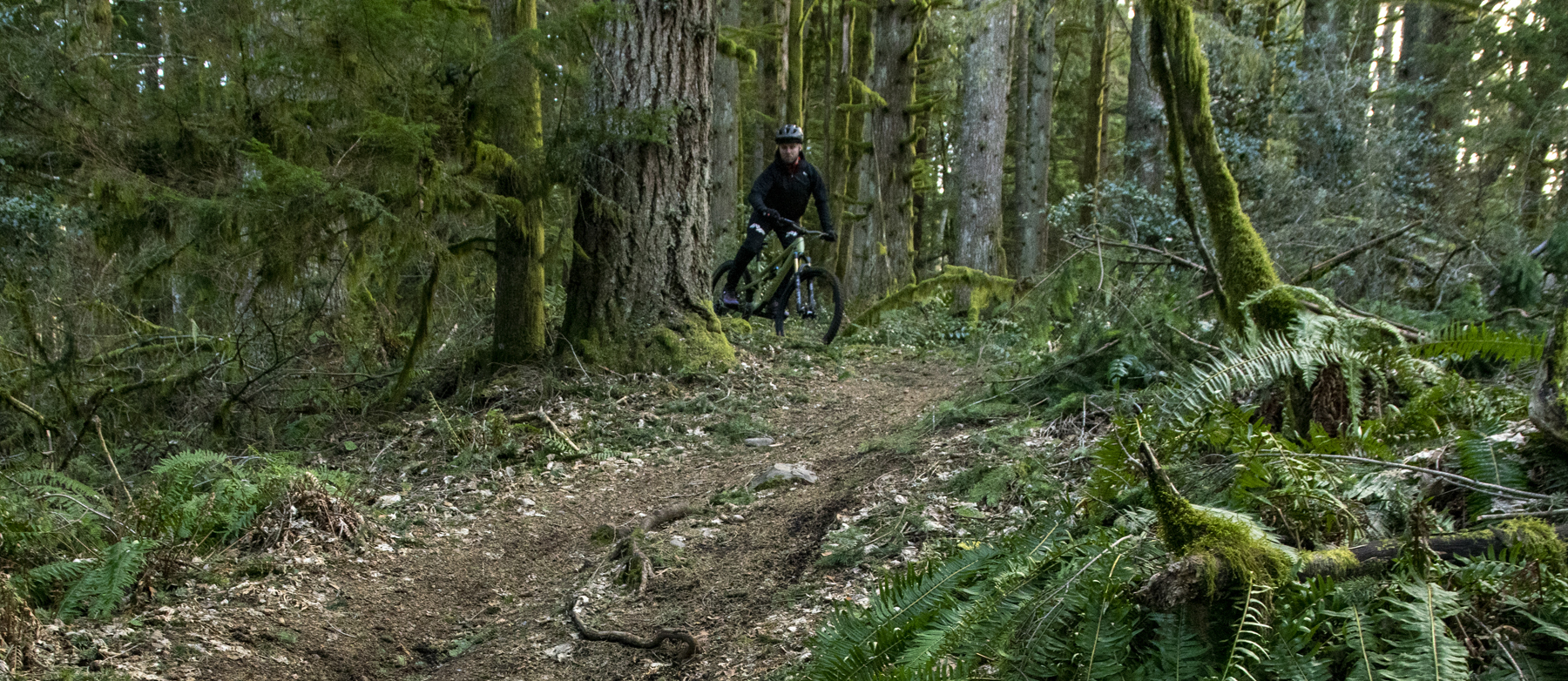
Who’s it For?
David: I have a hunch that the Spectral 125 is going to be a second (or third, or whatever) bike for a lot of people, and I do think it’s going to work best for folks who generally favor bigger, longer-travel bikes and who want something to make mellower trails more exciting than they are on their big bikes. The Spectral 125 isn’t especially efficient for a 125mm-travel bike and it gives up some versatility in exchange for being notably stable and game-on for its travel range. But if you want something that handles a lot like a bigger Enduro bike, but in a more lively, taut, shorter-travel package, the Spectral 125 is a ton of fun with the right riding approach.
Zack: “Downhiller’s Trail bike” was a hot term a few years back when brands were figuring out that shorter travel bikes could do more than just climb well, and I can’t help but revive the term to describe the Spectral 125. The Spectral 125 offers a very stable, capable ride in a short travel package, and it isn’t all that apologetic about its compromises in getting there. Riders looking for an engaging, encouraging partner on the climbs and on flatter, twisty trails will be better served elsewhere. However, for riders interested in a short-travel bike that can help breathe some life into their local trails while offering a lot of the stability and cockpit feel of an Enduro rig, the Spectral 125 is perhaps the most interesting and aggressive combination of those traits that I’ve ridden to date.
Bottom Line
Canyon has the right idea when they say that the Spectral 125 is a “short-travel bike for gravity riders,” but making that sort of bike is a fine balancing act. The Spectral 125 is definitely on the more aggressive, less versatile end of the spectrum for its travel range, but for precisely that reason it’s a whole lot of fun on the right trails and with the right riding approach. The Spectral 125 isn’t especially efficient under power for a short-travel bike and does need some speed to come alive, but if you’ve got fast, smooth trails where you can let it run, or want something to spice up the rougher trails where you’d typically ride a bigger Enduro bike, it’s a good time.

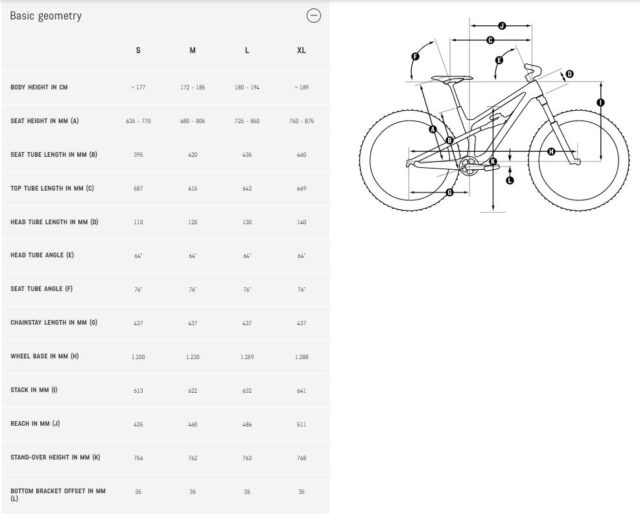
Got to say, I love shorter travel bikes with aggro geometry. And that’s not so I can mob over stuff at high speed. I just generally like the way a long, slack bike with long reach and high stack rides and feels. I’m happy on this kind of bike even on flatter smoother zoom around cross country terrain. It’s not frame angles that take the fun out of easy terrain on a big bike, it’s squashy and abundant travel. You get rid of some of that travel and you get some immediate tension in your platform and mellow terrain is really fun. It won’t be a cross country race bike, but the versatility of how much fun it is on easy terrain, and how gnarly you can get if you’re careful gives a wide band of utility for a one bike quiver for someone who usually rides easier than Enduro courses.
Haven’t been on this bike yet, but for me I like it on paper. Particularly built light with some of the newer very good down country type tires. I’m excited about it :-)
Great review, the comparison with other bikes is just what I was looking for and is specially helpful when deciding what bike to buy
This review is great, it’s one of the few that led me to buy the spectral 125 cf8. I generally ride more enduro orientated but have recently been putting in miles after work on my local less aggressive trails. This bike for me is fantastic. It pedals significantly better than a big bike, and allows you to really enjoy any type of defending. Big or small. Overall it’s the compromise I was hoping for. I generally like the fit and feel of more aggressive geometry bikes as I have never been one to hop on an xc bike and rather ride it. This checks the boxes for me, gives me the feel of my big bikes but much easier to get around on and brings more simple trails to life. I love it, glad I bought it. I’m 6’1 went with size large.
And let’s be honest if you are looking at this bike you’re not looking to buy an xc bike!